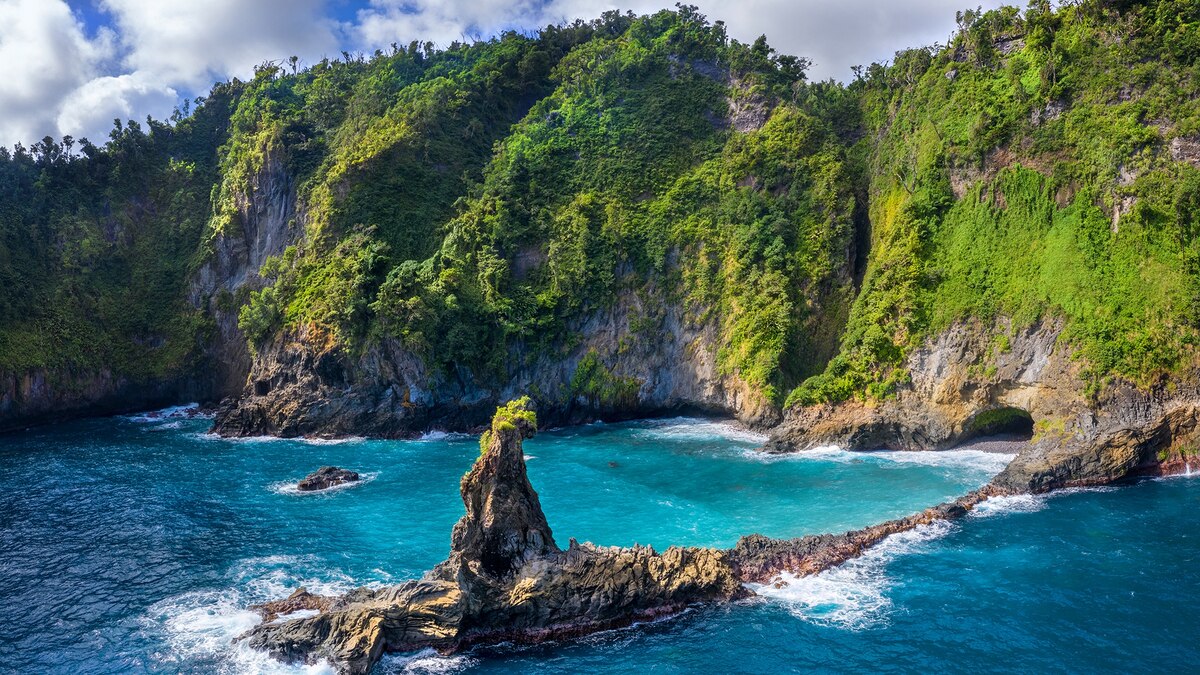Copyright National Geographic

Dominica fully lives up to its self-appointed nickname as the "Caribbean’s Nature Island." In a region that brims with pristine beaches requiring nothing more but to show up and relax, Dominica inspires travelers to get up and get moving. Rainforests blanket two-thirds of the island, and geothermal hot springs and waterfalls provide plenty of opportunity to walk, run, and take a cool dip. Singular geological formations sprung from volcanic activity, the longest hiking trail in the Caribbean, and more than 365 rivers—most clean enough to drink from—also dot Dominica’s rich topography. In the capital of Rosseau, neon colored tropical fruits spill over on tables at the Saturday outdoor market, Creole echo in the streets, and cruise visitors descend upon the entry port to embark on the impossible task of seeing everything the island has to offer in just a few hours. At the end of 2025, travelers will be able to experience Dominica in a new way thanks to the opening of the world’s largest cable car. The journey from above will offer views of the world’s second largest boiling lake, previously only visible after a six-hour hike. Multiple hotels and resorts are also in development, including Sanctuary Rainforest Eco Resort and Spa, Anichi Resort & Spa, and Fort Young Resort. And as the home to the world’s largest sperm whale population, the island will open its first whale reserve in 2026—furthering its commitment to marine conservation. (See all 25 destinations that made our list of the best places to visit in 2026.) What to do Morne Trois Pitons National Park: With nearly 300 miles of footpaths that lead to cascading waterfalls, boiling mud ponds, and small geysers, you could easily spend a few days at Morne Trois Pitons National Park. The UNESCO World Heritage Site is situated in the south central part of Dominica and contains some of the island’s most exhilarating natural wonders, including the world’s second largest boiling lake, a swimming hole called Titou George that was featured in "Pirates of the Caribbean: Dead Man's Chest," and one of the tallest waterfalls in the country, Middleham Falls. Waitukubuli National Trail: This 14-segment hike trail is the longest in the Caribbean, traversing 115 miles from Scotts Head in the south to Cabrits National Park in the north. Trails are suitable for all hiking levels, though it’s important to note that some hikes require an entry passport, which can be purchased in advance via the official Waitukubuli National Trail website. You can also experience the trail by sea on a six-day kayaking tour with Soufrière Outdoor Centre. This aquatic adventure includes 40-miles of exploration on the west coast, with stops to snorkel through crystalline waters and views of Morne Diablotins, Dominica’s highest peak. Kalinago Territory: Dominica’s Kalinago people are the largest Indigenous community in the Caribbean. Their deep reverence for the land is evident in their name of the island, "Waitukubuli," which means "tall is her body." Visitors should consider visiting their communities with Kalinago Tours. Experiences include witnessing the powerful Kalinago rituals, overnight stays in a traditional cottage, and hikes along the Asulukati River. Cultural festivals: Dominica comes alive with a palpable energy during Carnival season. Also known as Mas Dominik, the festivities include pageants and parades with Calypso music that take place on the Monday and Tuesday before Ash Wednesday. Each October, Dominica’s World Creole Music Festival lights up the stage with indigenous Dominican music and a number of global artists. Food vendors and evening parties make it a festive weekend of activity. When to go For dry and temperate weather, the months of December to May are your best bet. During this time, waters offer peak clarity for activities like snorkeling. This time of year is also peak tourism season, so book early, as hotels and airfare might reflect that demand with higher prices. The rainy season from June to November brings with it teeming plant life and intermittent storms to consider. The average year round temp is 80°F (27°C) and 88°F (31°C) in summer. In the historical French quarter of Rosseau, Lacou Melrose House serves gourmet cuisine that is often sourced from nearby farms and the sea just steps away. Grab a seat in their calming courtyard and enjoy bites of smoked marlin, roasted pumpkin soup, and their signature Lacou Punch, made with fresh lime juice, ginger bush rum, and dark rum. For a hearty and memorable breakfast, don’t miss a morning at Pearl’s Cuisine, where savory saltfish fritters called accra and cocoa tea usually sell out by noon. This Rousseau mainstay is one of the oldest restaurants on the island. Where to stay For an eco-friendly stay, consider the 14-suite, off-the-grid Coulibri Ridge, perched on a mountain ride on the southernmost part of the island. The property is powered by solar energy, and uses rainwater for the two chlorine-free pools. Rooms feature full kitchens and outdoor terraces that boast views of a verdant rainforest below. At the cliffside Secret Bay, 12 residential-style villas claim their position above a black sand beach and brimming rainforest. Guests can take yoga classes at the riverside Bwa Mang Wellness Pavilion and enjoy wellness treatments at the treetop Gommier Spa. Located at the bottom of Cabrits National Park, InterContinental Dominica Cabrits Resort & Spa offers four outdoor pools, beach access, and four restaurants. The proximity to Cabrits National Park’s hot springs is a major perk for anyone looking to get outside. Getting around American Airlines offers nonstop flights from Miami International Airport that fly directly to Dominica daily, Monday to Sunday. Other Caribbean islands that serve as hubs to Dominica include Puerto Rico (SJU), St. Maarten (SXM), and Guadeloupe (PTP). There are two airports on the island: Canefield or Douglas-Charles, where most visitors will arrive. From Douglas-Charles airport, a drive to the capital city of Rousseau takes approximately an hour. A new international airport, which will connect the island more seamlessly to the rest of the world, is slated to be completed by 2027. To get around the 29-mile long island, taxi services are readily available from the capital and most hotels. For car rentals, a driving permit (that costs about $12) is required and can be obtained at the airport, car rental agencies, and the Traffic Department office in downtown Rousseau. As the roads can be quite winding, consider a reliable private transportation service like The Master Taxi and Tours Dominica for transfer and tours around the island. Kristin Braswell is a travel journalist based in Los Angeles. She specializes in culture, food, design, and luxury travel around the world. She is also the founder of CrushGlobal Travel, a boutique travel planning service. Her perfect day includes soca music, rum, and the ocean. Follow her on Instagram.



